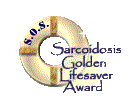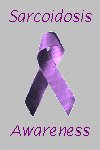|
Sarcoidosis, A
Medical Mystery What It Is | Who Gets It | What It Does | Statistics | Diagnosis | Treatment | Research | My Story | Links What It Is, What It Isn't Sarcoidosis is a relatively rare autoimmune disease that can affect the skin, lungs, heart, brain and nervous system, eyes, and other organs. Although the disease was first recognized about 100 years ago, little is known about what causes it and there is no cure. As an autoimmune disease, sarcoidosis is similar to diseases like rheumatoid arthritis and lupus in how it behaves and how it is treated. Depending on the severity, treatment may be needed to control what sarcoidosis does. Sarcoidosis can go dormant on its own or with treatment, and its symptoms often do not recur after the initial onset. In a small percentage of cases, sarcoidosis is chronic, requiring on-going treatment, with possible occurrence in other organ systems. Chronic sarcoidosis is apparently cyclic in its activity level, with flares of symptoms and more dormant periods lasting weeks or months. No markers have been identified as indicating how sarcoidosis is going to behave in any individual or how an individual with sarcoidosis is going to respond to treatment, although a physician experienced with sarcoidosis may be able to make a "good guess" based on his or her experience. Whether he or she is willing to voice that guess is another story entirely! Despite a century of research, little is known about sarcoidosis. Research has discovered what it is not. Among other things, it is not a cancer or tuberculosis or AIDS-related. It is not caused by pine pollen or other identifiable agents like pollution, airborne or otherwise. It is not progressive or contagious. You did not get it from someone else and you cannot give it to another person. As far as we know, nothing you did specifically caused your sarcoidosis. Who Gets It Sarcoidosis is most often diagnosed in young adults (20-40 years old), occurring roughly equally in men and women. It is much more common among African-Americans than among white Americans, and is very rare among Hispanic-Americans, Asian-Americans, and others racial groups in America. Demographics worldwide are variable, with the highest occurrences in Scandinavia and among white, red-haired Irish women. Although these facts are interesting, they have been of little help in identifying what causes sarcoidosis. What It Does In sarcoidosis, the immune system starts to attack the body's own tissues, forming small lumps called granulomas. These are like small scars that interfere with the normal function of the organ attacked by the disease. Even after treatment, the scarring can remain and can continue to have some effect on organ function. For example, sarcoidosis of the eyes can cause blindness if not detected and treated promptly, and pulmonary sarcoidosis can cause permanent scarring that interferes with breathing during exercise even with treatment. The majority of people diagnosed with sarcoidosis lead relatively normal lives after diagnosis, with or without treatment, despite the lack of cure. Some Statistics About half of all patients diagnosed with sarcoidosis have no or mild symptoms and do not need treatment of any kind. For example, a patient with no respiratory symptoms may have an abnormal chest x-ray during their yearly check-up. Further tests may or may not be ordered, and sarcoidosis is suspected but not confirmed. Since the patient is not bothered in any way, there is no need to do anything about it. The patient needs to be aware that they should have check-ups on a regular basis, just to make sure that their sarcoidosis is not starting to flare, and their doctor needs to be aware so that a sarcoidosis flare can be considered if the patient does report symptoms at a later time. About half of the rest receive treatment and go into remission, usually with no relapse. Those with sarcoidosis of the skin or eyes usually fall into this group, as do those with sarcoidosis of the lungs who have exhibited some mild to moderate symptoms. For these patients, sarcoidosis may be a bother for 6-18 months, but then live goes back to normal. Again, the patient needs to be aware that regular check-ups are important, and their doctors need to be aware of that history. For the remainder, sarcoidosis is considered to be chronic, never quite going completely into remission, even with treatment. Serious pulmonary sarcoidosis with life-threatening symptoms, neurosarcoidosis, and cardiac sarcoidosis are most commonly this type. For these people, sarcoidosis alters what has been known as normal. Even with the more serious forms of sarcoidosis, though, life can be relatively normal. The patient with chronic sarcoidosis may need to make some changes to accommodate their new limitations, but they can continue most if not all of their normal activities, even going on to have children. On-going treatment for sarcoidosis can have an impact on normal life, from side effects to scheduling regular visits to receive one's treatment. Chronic sarcoidosis is like any other chronic illness is this respect. Unfortunately, about 5% of those diagnosed die as the result of this disease. Death results because the granulomas have a severe impact on a major organ like the heart or brain, and cannot be controlled with the available treatments. There is hope, though. New treatments are being tried for chronic sarcoidosis of these major organs, in attempt to prevent death from this disease. Again, these statistics are interesting, but not terribly important for the average person just diagnosed with sarcoidosis. This disease is very individual, with each person showing a unique collection of symptoms which can be attributed to their sarcoidosis, before diagnosis, during treatment, and afterwards. How It's Diagnosed There is no one test specific for sarcoidosis. Sarcoidosis of the lungs is usually diagnosed using chest x-rays, pulmonary function tests, blood tests, and bronchoscopy with lung biopsy. Similar tests are used for suspected sarcoidosis of other organs. The diagnosis is by elimination of other possible conditions rather than specific identification of sarcoidosis, although the results of biopsy are definitive for the identification of granulomous tissue. How It's Treated Sarcoidosis is usually treated with steroids initially. For sarcoidosis of the skin or eyes, the treatment is topical (as a cream or ointment), although injection of steroids into the eye may be needed if serious iritis or uveitis is found. Oral steroids - e.g. prednisone or prednisolone - are used for other forms of sarcoidosis, with treatment lasting from 6-12 months. These drugs suppress the immune system so that the sarcoid granulomas can (hopefully) heal themselves with little or no lasting damage. If the patient does not respond to this treatment in few months or long-term treatment is necessary, small doses of other drugs like methotrexate, cytoxin, and imuran may be used. These are cytotoxins (cell-killers) often used to treat cancer. In very small doses, though, they are relatively safe immuno-supressives. Thalidomide has also been used recently to treat neurosarcoidosis and cardiac sarcoidosis when steroids are not effective or must be continued long-term to control the disease. Although these drugs are much more powerful than even steroids, they tend to have fewer overall side effects and the serious side effects can be more easily detected while still mild and before long-term damage occurs. For chronic sarcoidosis patients, treatment is usually a trade-off between side effects and the effects of the sarcoidosis itself. Hope for the Future Since sarcoidosis is relatively rare, there is no great fund of money for research into its causes and potential treatments or cures. There is some work ongoing, in the U.S. and world-wide, mostly at very low levels such as cellular physiology, immunology, and genetics. For example, one recent publication had an article from a group in Japan that has discovered what may be a marker for a genetic risk factor for sarcoidosis. Whether work at this level will lead to anything of clinical use remains to be seen, but these published results are small steps along the path to understanding of this disease. Research specifically into sarcoidosis may not be "high profile" or widespread, but work in other areas may also lead to hope for sarcoidosis patients. The use of thalidomide for neurosarcoidosis directly stems from the clinical work with this drug and rheumatoid arthritis, "crossover" from other research. Also, work with various drugs for asthma and cystic fibrosis may help the patient with chronic pulmonary sarcoidosis, at least symptomatically. It is impossible to predict the direction from which a major step in the understanding of this disease may come, but there is research and there is hope. From Personal Experience Diagnosis & Fear For myself, being diagnosed with sarcoidosis was very frightening: a potentially life-threatening disease with unknown causes and no cure. At first, I did not even know what questions to ask, because I had never heard of sarcoidosis despite being well read about medical matters. A few days of browsing on the web, seeking information about sarcoidosis, lead to a point where I at least knew what questions I needed to ask the doctor about my disease and its treatment. I was fortunate to have a doctor willing to sit down with me and answer my questions. I made an appointment with him specifically for that purpose, and I did get some reassurance from the answers I received. Since then, I have continued seeking information about sarcoidosis and have made a great many friends on the web with this disease and other lung diseases who have been able to provide me with support as well as information. For me, understanding what is known about this mystery disease has help ease the fear. Sharing what I have learned about this disease has given me strength and hope that are not available to me otherwise. Grieving for a Lost Self Any diagnosis of chronic disease starts a grieving process. I had to give myself time to accept that I have a disease for which there is no cure, which has forced me to make changes in my life. I had to mourn the "normal self" I once was and no longer can be. I had to go through the grief process, through anger and bargaining and questioning and depression, to reach acceptance. And this while on steroids! A loving though clueless husband has been my most important support, thank God! He has little understanding of what this disease is and exactly what it does to me on a day to day basis, but accepts me no matter how rotten I feel or how outrageous I've been behaving from the steroids. Like most of those close to us with chronic illnesses, my husband does not really want to know all about my disease. I think he too is somewhat frightened by the idea that this thing could kill me. I am fortunate, though, that he is accepting and loving, even without that kind of understanding. The rest of my support has come from online friends with sarcoidosis and other lung disease who have "walked the path before me." They understand in a way my husband cannot what I am truly coping with on a daily basis. I've come to realize that I need both kinds of support to fully cope with this chronic illness. A Partner in My Medical Care Since my diagnosis in March 1998 and the subsequent realization in September 1997 that I have chronic pulmonary sarcoidosis, I have learned that it is important to become a partner in my own medical care. As I have learned about this disease and about myself, I have come to realize that I will not see a doctor who is not willing to work with me and treat me as a reasoning, adult human being, without patronizing me and without scorn for what I may or may not know about my condition. I have one doctor who acts as coordinator of my care, keeping track of all my medications and receiving notes from all of the other doctors I see to collect all of this information in one place. I see specialists to deal with specific issues and problems, with any information from them returned to that coordinator. A Note About Health Insurance Like most working Americans, I am covered by private health insurance. As a person with a chronic disease, I've learned that I need to make sure that my medical coverage continues if and when I change jobs, so that insurers are not given the opportunity to not cover me. This may sounds like I am trying to trick the insurers, but I do not see it that way. There are many ways for them to see that I do not abuse the system even though I may submit the most claims of anyone in my group health plan. I am entitled to that coverage under the law, and will take whatever steps are needed to see that I get it. Sarcoidosis on the Web There are a number of sites with information about sarcoidosis on the Internet. A few are listed below. For straight information, sites from the National Institutes of Health, Vanderbilt University, National Jewish Medical Center, and the Cheshire Medical Center are the best. Their facts are reliable and each one has slightly different information about this disease, especially the minor symptoms and effects. These sites can be quite technical, though, so be prepared to either look up unfamiliar terms or get lost in the "pidgin Swahili" of medical and biochemical jargon. For online support, the Chronic Lung Disease Forum and the Sarcoid Connection are both great sites. The former has a bulletin board to which you can post messages and communicate with other chronic lung disease patients, and the latter is a site run by a sarcoidosis patient with a chat room. There are also sites sponsored by sarcoidosis support groups and activist organizations trying to garner support for sarcoidosis research. More sites are being added regularly, by those with this disease and by those who treat this disease. Type "sarcoidosis" into the search box of your favorite search engine for more links. Like any medical information on the web, though, consider its source (hospital or research center, an individual or support group) and take any questions you have to your doctor for answers.
Sarcoid Connection
To learn more about Sarc please visit award & webring sites below. NoAir's honored to have received the following awards:
|



